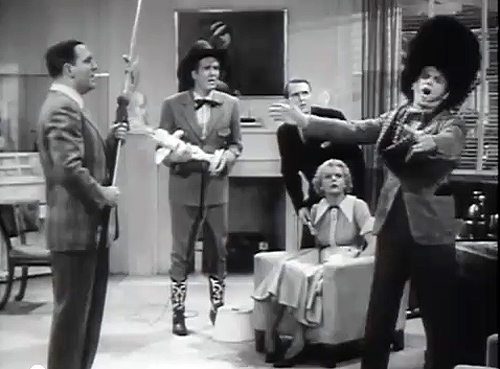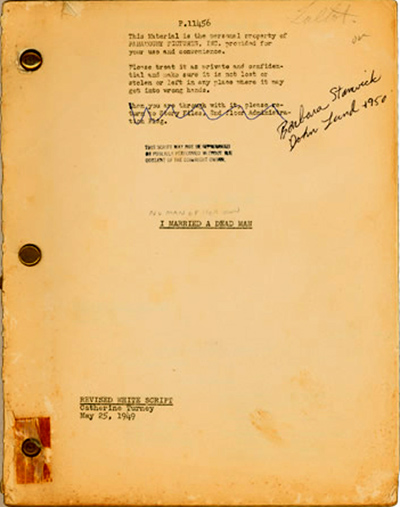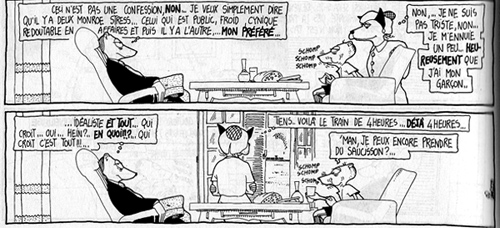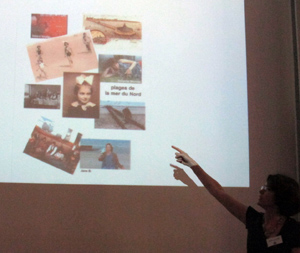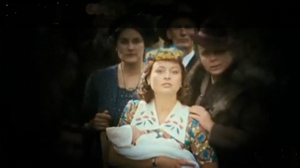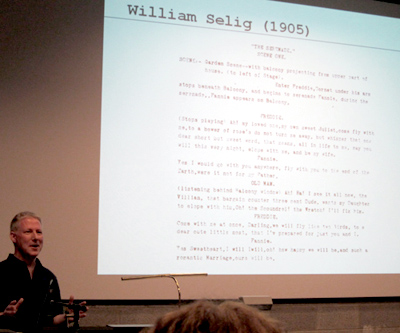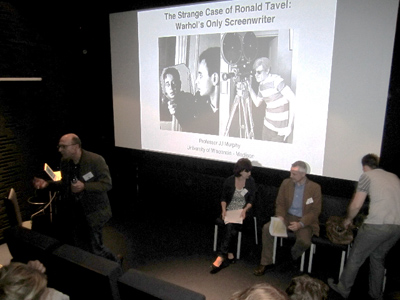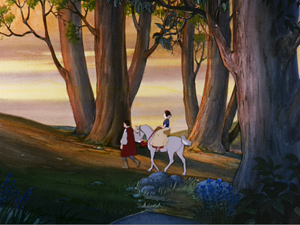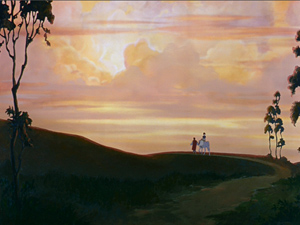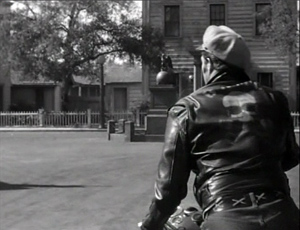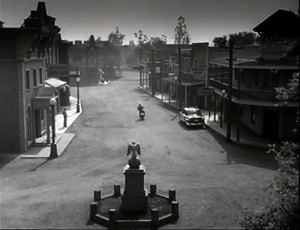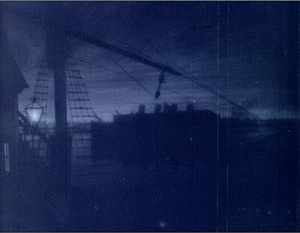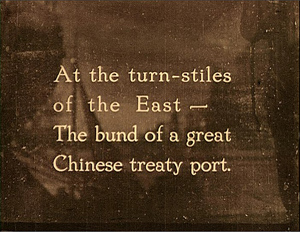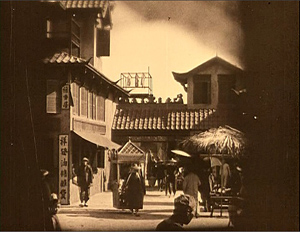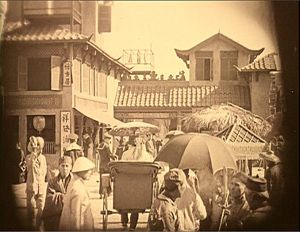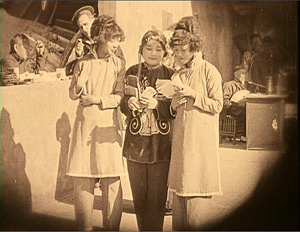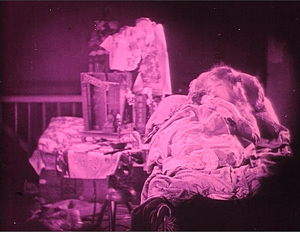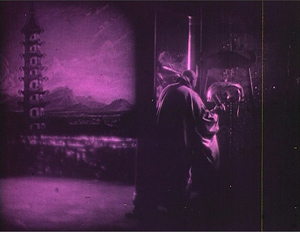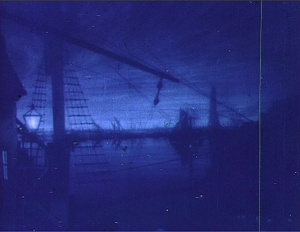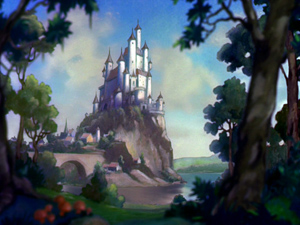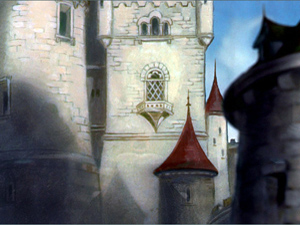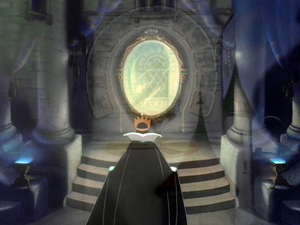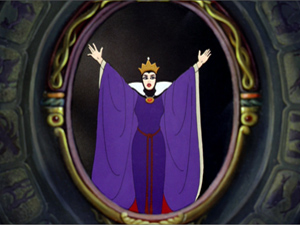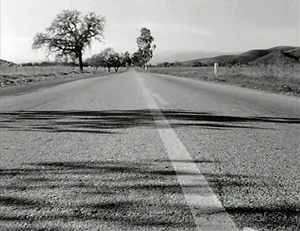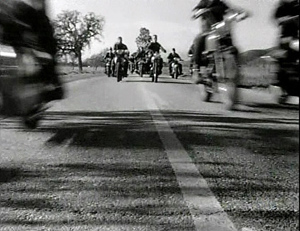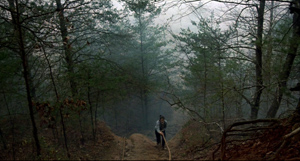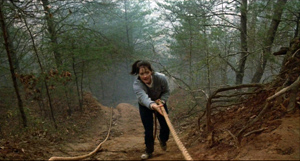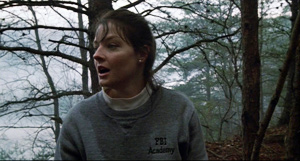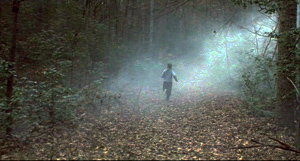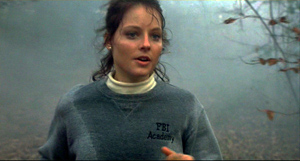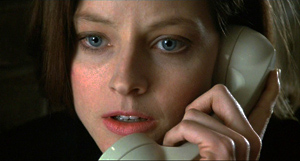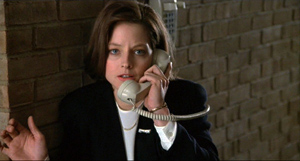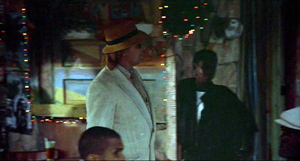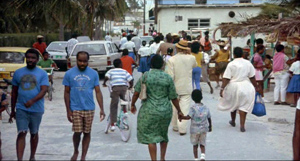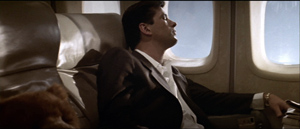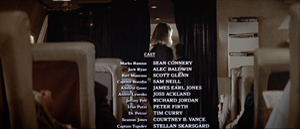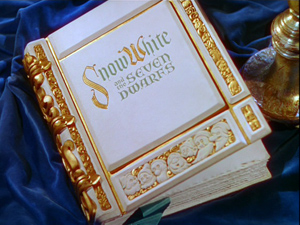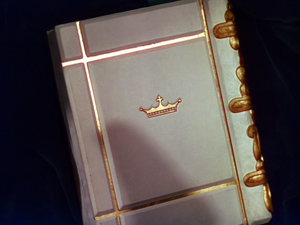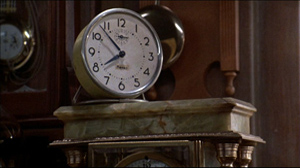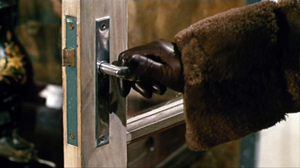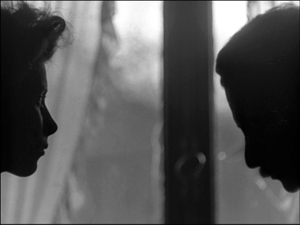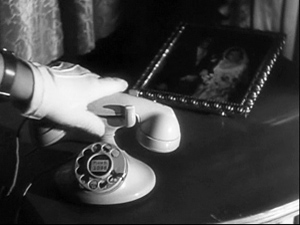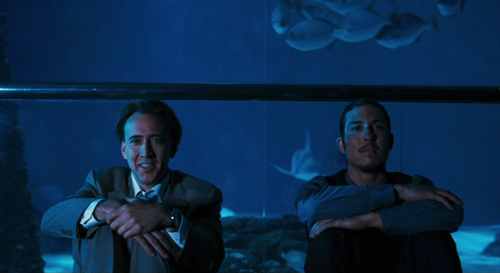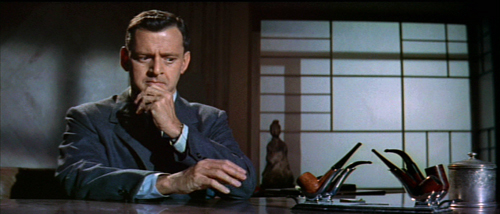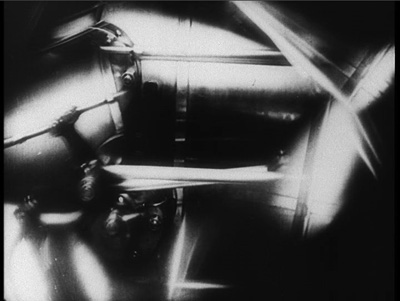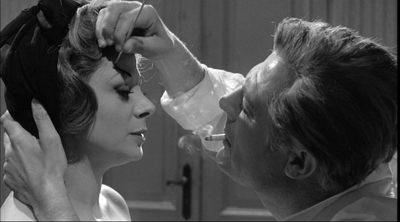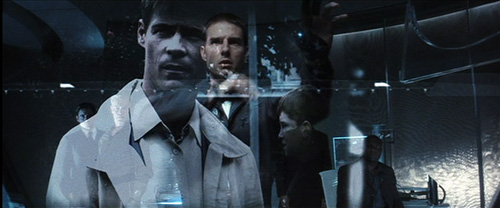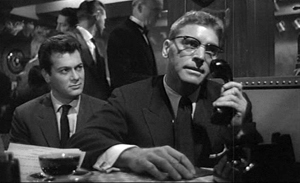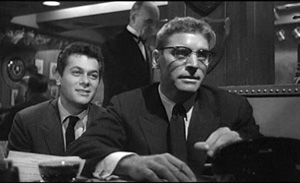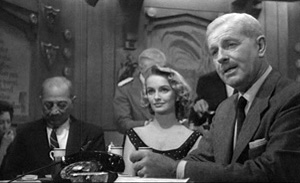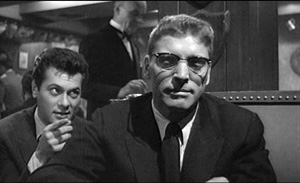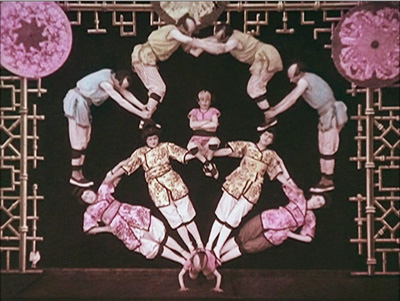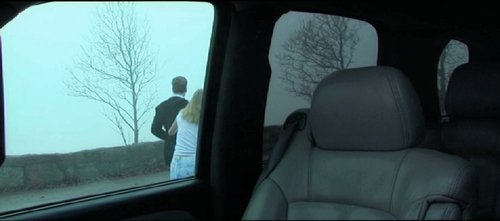Archive for the 'Film theory' Category
Scriptography
Hollywood screenwriters at work, according to Boy Meets Girl (1938).
It’s not every conference that opens a morning session by asking the men in the audience to take off their underwear.
But I anticipate.
Last weekend I was a guest of the Screenwriting Resource Network’s fourth annual Screenwriting Research Conference in Brussels. I think that a hell of a time was had by all, and I learned quite a bit, including some reasons why people are interested in screenplays.
Schmucks with Underwoods
Catherine Turney script for No Man of Her Own (1950).
In my youth, there seemed to be a solemn pact among my peers that we would never study certain areas: censorship, audiences, adaptation (novels into film, particularly), and screenwriting. An earlier generation had, through patient labor, shown decisively that these subjects were dead boring. We, on the other hand, were fired by notions of the director as auteur, and indifferent to what were called “literary” and “sociological” approaches to film. So we triumphantly turned toward The Text—that is, the finished movie.
Things have changed since then. Yet there are still tempting reasons to consider the study of screenwriting a nonstarter if you’re interested in cinema as an art. If you think of the finished film as the achieved artwork, then study of screenplay drafts risks seeming irrelevant. Whatever the screenwriter(s) intended seems irrelevant to the result. So what if six or more screenwriters labored over Tootsie? The movie stands or falls by what we see onscreen.
This was the view presented in Jean-Claude Carrière’s three talks to our group. He suggested that the screenplay is destined to become landfill, and rightly so. It’s like the caterpillar that becomes a butterfly. Once the film has been made, the script has no intrinsic value.
Someone might say, “Wait! We study a painter’s sketches, a novelist’s drafts, or a composer’s early scores. These materials can contribute to understanding the finished work, and sometimes they have an artistic value of their own.” The problem is that in these arts, the preparatory materials are in the same medium as the result. But a script can’t count as a version of the film because prose can’t adequately specify the audiovisual texture of a movie. It’s commonly thought, plausibly, that giving the same script to two directors would result in significantly different films. So the script is at best a series of suggestions for filming, not a sketchy version of the movie. Why not discard it when the film is done?
The study of screenwriting has probably also lain in the shadows because of the proliferation of screenwriting gurus and how-to manuals. Every American over the age of eighteen seems to be writing a screenplay; the Cable Guy who visited me last week was working on two. So all the seminars and advice books have arguably put thinking about screenplays rather close to the amateur-script racket.
Moreover, screenplay studies seem to be part of a broader, paradoxical development in academic film studies. Today scholars have more access to films than ever before, thanks to video, festivals, archives, and the internet. Yet many researchers prefer to talk about everything but the film. More and more scholars want to study just those subjects that my cohort considered dull or irrelevant: censorship and regulation, audiences (composition, demographics, critical reception, fandom), and preproduction factors (storyboards, scripts). In addition, many academics have turned to bigger thematic ideas like film and architecture, film and the city, film and modernity. These trends of research usually make only glancing reference to actual movies, mostly mining them for quick illustrative examples.
In sum, many academics have abandoned the study of film as an artistic medium that finds its embodiment in important works. To get to know particular films more intimately, you increasingly have to go to the Net, to writers like Jim Emerson, Adrian Martin, and other sensitive analytical critics. Talking about screenwriting can seem to be another way of avoiding coming to grips with the intrinsic power of movies.
You can probably tell that one side of me shares some of the biases I’ve listed. But when I remind myself that what people should study aren’t topics but questions, I cheer up quite a bit. For there are, I think, worthwhile questions to be asked about all these areas, screenwriting included. The Brussels event gave some good instances of resourceful, occasionally exciting research into them.
Based on my short acquaintance, most of the research questions seem trained on one of two broad areas: Screenwriting and The Screenplay.
In the trenches
Kinky & Cosy
Screenwriting can be thought of as a practice, a creative activity with both personal and social aspects. How, we might ask, do screenwriters or directors express themselves in the script? How does a media industry recruit, sustain, and reward screenwriters? What are the conventions and constraints at work in a particular screenwriting community?
Questions like this are somewhat familiar to me. When I wrote my first book, on Carl Dreyer, I had to examine his scripts (notably the unproduced Jesus of Nazareth), and that helped me understand his characteristic methods of researching and planning his films. Later, when I collaborated with Kristin and Janet Staiger on The Classical Hollywood Cinema, I recognized a more institutional side of things. We can see from the films of the 1910s that filmmakers were cutting up the space in fresh ways. But this wasn’t a matter of directors simply winging it on the set. Kristin used published manuals and Janet used original screenplays to show that shot breakdowns were planned to a considerable degree before shooting. This habit made production more efficient and controllable.
At the Brussels get-together, Steven Price offered further evidence of this sort, which displayed some of his research on early scenarios for Mack Sennett movies like Crooked to the End (1915). Interestingly, Steven found that sometimes the later version of a continuity script was more laconic than the initial one. Perhaps the gags, once spelled out in the first draft, could be left up to the actors. This is the sort of thing he identified as a “trace” of production practices.
A parallel of sorts emerged in Maria Belodubrovskaya’s paper on screenwriting under Stalin. The Soviets, admiring Hollywood efficiency, tried to come up with a similar system. But their efforts to produce films in bulk were blocked by a censorship apparatus bent on ideological correctness. No surprise there, I guess. But Masha showed convincingly that the very efforts to mimic Hollywood’s “assembly-line” system also discouraged authors from submitting scripts. The writers thought (like many of their LA counterparts) that such a setup denied them creative freedom. In addition, the prospect of story departments providing a stream of screenplays ran afoul of the tradition that gave the director control of the final draft. And the role of producer, as one who could steer the whole process, didn’t exist! So much for the Soviet Hollywood.
What about other media? Sara Zanatta traced out the process of creating Italian TV series. She reviewed some major formats (miniseries, original series, adaptations of foreign series) and then took us through the process of creating individual episodes. Interestingly, it seems that the Italian system, unlike US television, makes the director the boss of it all. Frédéric Zeimat explained how he gained entry to the local screenwriting community through his university education, including work in Luc Dardennes’ workshop at the Free University of Brussels. Eventually he came up with a script that won prizes. He is about to become a showrunner for a sitcom.
One of the most stimulating panels I heard considered the writing of graphic novels and animation. Richard Neupert explored how recent French animation sustained the tradition of individual authorship while still acceding to some international norms of moviemaking. The cartoonist Nix discussed how he faced new problems in transferring his three-panel comic strip Kinky & Cosy from print to television. TV demanded less written text, especially signs, so that the clips could be exported outside Belgium. More deeply, Nix had to rethink how to pace the action and leave a beat (say, two seconds) after the punchline.
Pascal Lefèvre, one of Europe’s leading experts on comic art, provided a brisk, packed account of the history and practices of scriptwriting for Eurocomics. He described patterns of collaboration, format, and creative choice, placing special emphasis on comics as a spatial art different from cinema. His example was a page from Regis Franc’s ulta-widescreen album Le Café de la plage. Here’s a portion in which two periods of Monroe Stress’s life coexist in a single space. He muses as an adult while his childish self gobbles up food under the guidance of Mom.
Comics space can also change abruptly, as when a window appears in second panel.
Other papers presented less institutionally fixed, more personal versions of screenwriting as a practice. Kelley Conway’s lecture on Agnes Varda exploited unique access to the filmmaker’s notebooks, scrapbooks, and databases. Kelley showed how Varda conceived three of her documentaries by means of strict categorical structures that were then frayed by digressions born out of the material she shot.
Anna Sofia Rossholm provided something similar for Bergman. Out of the vast Bergman archive she quarried sixty “workbooks,” typically one for each film. Whereas Varda’s books were filled with cutouts and images, Bergman was a word man, treating the books as diaries that recorded “this secret I.” Anna Sofia proposed that in his jottings and planning, Bergman not only communed with himself (calling himself an idiot on occasion) but also explored patterns of doubling akin to those we find in the films. The workbooks evidently held a special place for him: he included their pages in films like Hour of the Wolf and Saraband.
David Lean might be thought of as working in between the Hollywood system and the more personal European milieu. Ian Macdonald suggested that one of Lean’s unfilmed projects sheds light on what he calls screenplay poetics. Macdonald seeks, I think, a principled method for studying the creative process. He does this by tracing how a screen idea is transformed in a series of documents generated by the creative team. The process, he points out, is governed by the participants’ various conceptual frameworks. For Nostromo, Lean solicited two screenwriters and oversaw their rather different versions of the novel. Ian showed that Lean seems to have found solutions to adapting the book by fitting it to the three-act structure advocated by Hollywood artisans, a concrete case of a filmmaker accepting a fresh “poetics” or set of creative constraints.
All of these inquiries could lead to more general thoughts about the creative process in cinema. For some filmmakers, it’s a professional task, undertaken with full knowledge that problems and constraints will have to be dealt with. For others, such as Bergman and Varda, it’s obviously deeply personal, even autobiographical. Perhaps most intimate was the film discussed by Hester Joyce. New Zealand filmmaker Gaylene Preston based Home by Christmas (2010; above) partly on audiotape interviews with her father as he recalled his World War II experiences. Her script reconstructed her interviews with actors, then filled in scenes with documentary footage and scenes she imagined. It’s a family memoir on several levels: Preston’s daughter portrays her own grandmother.
The Screenplay: What is it?
Several of these probes into the creative process raise a more theoretical question. How should we best conceive of the screenplay? As a blueprint? A recipe? An outline? These labels all suggest something disposable preliminary to the real thing, the movie. But why can’t we think of the screenplay as a freestanding object? After all, there are films without screenplays, but there are also screenplays—some written by distinguished authors—that were never made into films. And some of these, like Pinter’s Proust screenplay, are read for their own sake.
In cases like this, should we consider the screenplay a literary genre? And if the screenplay for an unproduced film can be considered a discrete object, what stops us from treating a filmed script in exactly the same way? Moreover, why even speak of a single screenplay, when we know that most commercial films at least go through several drafts? Can’t we consider each one an independent literary text? We’re now far from Carrière’s idea that the script finds its consummation in the finished film and as a piece of writing it should wind up in the ashcan.
And not all screenplays are literary texts. The scrapbooks and databases that Varda accumulates are works of visual art, collages or mixed-media assemblages. Are these merely drafts of the film, or do they have an independent existence or value? We seem to be asking the sort of question that Ted Nannicelli poses in his Ph. D. dissertation. Is there an ontology of the screenplay?
Take a concrete example. Ann Igelstrom’s paper, “Narration in the Screenplay Text,” asked how literary techniques are deployed in the screenplay. When a passage in the script for Before Sunset begins, “We see…,” who exactly is this we? Ann argued that traditional narrative concepts involving the source of the narration, the implied author and implied reader, and the rhetoric of telling can illuminate conventions of screenwriting. Here the screenplay seems definitely a literary text.
In his keynote address, “The Screenplay: An Accelerated Critical History,” Steven Price (above) declared a more abstract interest in the ontology of the screenplay but proposed that there was no clear-cut way of defining it. Historically, the screenplay takes many forms. Steven pointed out that even in Hollywood, there were many alternative formats, ranging from detailed breakdowns to the “master-scene” method (the option that didn’t specify shots or camera positions). And conceptually, the screenplay carried traces of its original production purposes, as well as other constellations of meaning. (Mack Sennett scripts seem to him part of a Sadean tradition of dehumanized, repetitive recombination.) So if there is a distinctive mode of being of the screenplay, outside of its role in production, it will turn out to be a messy one.
Envoi
J. J. Murphy presents a paper on Ronald Tavel. Photo courtesy Richard Neupert.
If we conceive studies of screenplay and screenwriting as revolving around specific research questions, those of us interested in film as art can learn a lot. If our interests are in film history, researchers can show how organizations of production and individual choices by screenwriters/directors can shape the final product. For those of us interested in more theoretical explorations, asking about the nature and “mode of being” of the screenplay can’t help but make us think more about the ontology of cinema itself.
And if we want to know films more intimately, being aware of the creative choices that were made by the filmmakers throws a spotlight on aspects of the film we might otherwise not notice. It’s all very well to say we’ll examine the film “in itself,” but our attention is invariably selective. Knowledge of behind-the-scenes decisions can sharpen our awareness of artistic matters. Anna Sofia’s research on Bergman, like Marja-Riitta Koivumäki’s paper on Tarkovsky’s screenplay for My Name Is Ivan, activates parts of the film for special notice.
Because there were split sessions at the conference, and because I was plagued by jet lag, I couldn’t attend every panel and talk. I regret missing papers I later heard were very fine, and I haven’t written up everything I heard. I haven’t sufficiently talked about screenwriting pedagogy, represented in papers like Lucien Georgescu’s dramatic appeal to rethink whether screenwriting should be taught in film schools, or Debbie Danielpour’s stimulating survey of her methods of teaching genre scripting. So this is just a small sample of what these folks are up to. But you can tell, I think, that they’re posing questions at a level of sophistication that my 1960s cohort couldn’t have envisioned. Despite what the cynics say, there is progress in academic work.
As for men’s underpants: All is explained here.
I’m grateful to conference organizers Ronald Geerts and Hugo Vercauteren for inviting me to speak at the gathering. I must also thank conference organizer and old friend Muriel Andrin, along with Dominique Nasta and their colleagues and students from the Arts du Spectacle Department at the Université Libre de Bruxelles. My friends at the Cinematek, Stef and Bart and Hilde, helped me with my PowerPoint. Thanks as well to the Universitaire Associatie Brussel (Vrije Universiteit Brussel / Rits-Erasmushogeschool Brussel) and Associatie KULeuven (MAD-Faculty / Sint Lukas Brussel). A high point of the event was the visit to La Fleur en Papier Doré. Special thanks to Gabrielle Claes for her heartfelt introduction to my talk, not to mention a delicious bucket of moules.
A founding document in the contemporary study of the screenplay is Claudia Sternberg’s Written for the Screen: The American Motion-Picture Screenplay as Text (Stauffenburg, 1997). Other books central to the conference cohort include Steven Maras’s Screenwriting: History, Theory, and Practice, Steven Price’s The Screenplay: Authorship, Theory and Criticism, J. J. Murphy’s Me and You and Memento and Fargo: How Independent Screenplays Work, and Jill Nelmes’s anthology Analysing the Screenplay, which includes many essays by members of the group. See also the affiliated Journal of Screenwriting.
For more information on the Screenwriting Research Network, go here. (Thanks to Ian Macdonald for the link.) The next conference will be held in Sydney, and the 2013 one will take place in Madison, Wisconsin.
P.S. 22 Sept 2011: A panel discussion with Jean-Claude Carrière held during the conference is available here. Although the site is in Dutch, the discussion is in English. Thanks to Ronald Geerts for the information.
P.P.S. Thanks to Joonas Linkola for a spelling correction!
Coke does go through you pretty fast. Richard Neupert at a Coca-Cola machine that exploits a Brussels landmark.
Molly wanted more
The Crime of M. Lange.
DB here:
I was watching Snow White and the Seven Dwarfs some years ago with a friend’s three-year-old daughter. Molly hadn’t seen the movie before, and she watched it in a fascinated silence. At the end, Snow White and the prince leave the dwarfs and ride off into the distance.
At this point Molly cried, “More!”
This surprised me. How could she know, on her first pass, that the story was ending?
In and out
It has no name that I’m aware of, but it’s one of the most common conventions of movie storytelling. At the end of the film, the story world closes itself off from us. The characters turn away, perhaps walking into the distance. We may get a distant long shot of the scene. In some cases the camera accentuates this withdrawal by craning or tracking away from the action.
At the end of The Wild One, the biker hero smiles at the woman he’s met and goes out into the street. After exchanging a glance with the ineffectual sheriff, he swings his motorcycle around, his back to us. Cut to an extreme long shot as he rides off.
Once you notice this sort of ending, you’re likely to think about beginnings. Sure enough, we find some symmetry. A movie often visually brings us into the story world. Most common is an inward progression, moving from a large view to the central space of action. As far back as 1919, Griffith started Broken Blossoms with an overall view of the harbor and an explanatory title.
Then we have a gradual entry into the Chinese neighborhood, moving steadily from long shots to closer views. The young ladies we encounter aren’t major characters in the plot, but we’re still slowly drawn into the story world.
At the film’s end, Griffith’s cutting will manage a parallel withdrawal, from the lovers to the temple and back to the waterfront view.
In fact, Snow White starts with a comparable, if somewhat smoother shift inward, from the exterior of the Queen’s castle then, via camera movement and dissolves, to the Queen at her mirror.
This last shot reminds us that alternatively, a film can start with the characters coming forward, as if to meet us. This is the way The Wild One begins.
Any sort of combination is possible. The Silence of the Lambs starts with Clarice Starling climbing up a hill toward us and pausing long enough for us to register her as a protagonist.
She then turns and runs off into the forest. If this were an ending, we might see her go off further and further into the distance. But this is an opening, so we follow her with a tracking shot forward, letting her lead us into the story action. Soon we’re back to the frontality and intimacy of an opening passage, like the shot of the Queen.
At the end, Jonathan Demme gives us a pair of “farewell” shots. The first occurs when Clarice, who’s been talking to Dr. Lecter on the phone, hears the line go dead. We pull away from her.
The second farewell shot takes place on Lecter’s end in a Caribbean island. It shows him rising to follow Chilson and walking away from us, to be swallowed up into the crowd.
The Silence of the Lambs takes leave of its protagonists in two alternative ways: If the camera doesn’t move away from our characters, it seems, then the characters move away from the camera. They may even seal themselves off, as when a flight attendant pinches shut the curtain at the end of The Hunt for Red October.
So when we speak of films’ “openings” or “closings,” it seems that we are often talking about a world that initially invites us in but will finally expell us, however slowly and politely.
See it here!
Researchers play Jeopardy! Their answers always take the form of a question. Most film critics work in the declarative mode (“The performances are gripping”), but ideally the academic film researcher works in the interrogative mode. What is this pattern of beginnings and endings doing in movies? How does it work? How did it become common? And how do we learn it?
Take the first question, about the purposes and functions of the device. At one level its neat symmetry mimics the sort of frame that we find in other sorts of narrative, particularly oral storytelling. Fictional stories need to be set off from the surrounding flow of discourse. When we hear “Once upon a time,” we all know a fairy tale is starting. There are equivalents in other oral traditions, as in “Here is a tale . . . .” (Yoruba) and “See it here!” (Hause).
Likewise, oral storytelling traditions use formulaic final lines. In our fairy tales, it’s often “And they lived happily ever after.” Native American folk tales may finish with the storyteller simply saying, “The end” or “Tied up.” African oral epics sometimes use the formula “That is what I know” or “Let us leave the words right here.”
In fact, I cheated a little with my examples from Snow White. The film actually is bracketed by a literal opening and closing.
In film, however, the symmetrical structure is only part of the answer. While a film can copy the literary idea of opening and closing a written text, the medium as a whole offers something more. Thanks to the visual nature of movies, the widening or closing-off of the story world can mimic the act of our entering or backing out of a tangible situation. That’s what we see in Snow White and my other examples. In a sense we greet the characters, and after spending some time with them we bid them farewell. The sense of entering and leaving their world is harder to capture so concretely in literature or theatre.
So we need a more specific account of the convention. Surely you’ve thought about the most obvious candidate. The entry/ leave-taking pattern mimics our activities as perceiving, socially inclined people. For creatures like us, to encounter a new situation or setting simply involves approaching it or letting it approach us, then becoming part of it and fixing our attention on its details. At a party, we amble closer to a knot of people we want to talk with, or someone comes up to us. Sooner or later that encounter ends or trails off, and we withdraw or turn away or watch when others depart. More poignantly, the extreme long-shot option can recall moments when a car or bus or train carried us away from our loved ones. In any case, thanks to moving images the salient features of this very common experience can be made tangible for viewers.
This convention, we might say, is just natural. Molly, who had already logged three years of social experience, could plausibly make the analogy with ease. She recognized that her encounter with the world of Snow White was coming to an end–the characters were leaving her–and could express her regret.
This common-sense answer is, I think, basically right. But it needs to be fortified against some objections.
For one thing, not all films use this convention. Lots of films start with close-ups of particular items in an environment, plunging us into details without a gradual entry (below, Back to the Future; Muriel; ou le temps d’un retour).
And lots of films don’t end with marks of withdrawal or closure. They end on close views, often of the characters or a significant object (below, Le Silence de la mer; Sorry, Wrong Number).
If this pattern were biased by our natural proclivities, wouldn’t it be more common than it is? And if it comes so naturally, why wasn’t it present at the start of cinema, as soon as people started telling stories? Most of the storytelling techniques we now consider very user-friendly, like cutting and camera movement, emerged after many years of moviemaking. It’s akin to a problem in the history of painting: Why did painters need centuries to learn to imitate the way things look?
Moreover, the naturalness can look pretty unnatural. Nobody lies down in the middle of the road to let a horde of bikers sweep by, as in the beginning of The Wild One. The high angle at the end of the movie doesn’t imitate anybody’s likely point of view; it mimics, if anything, a godlike perspective we almost never get. Similarly, the cuts and dissolves that link the views in Broken Blossoms and Snow White don’t have any parallel in our real experience. Tied to our bodies, we can only move toward or away from situations in real time, step by step. The time-compression and freedom of position we get on film are far from natural. In sum, the concrete ways in which this immersion/ withdrawal pattern shows up in actual movies suggest that the films aren’t imitating the literal vantage points we might assume in the real world. There is a lot of contrivance going on.
Real life, amped up
So the convention has some roots in our perceptual and social experience, but filmmakers have streamlined and sharpened it for our uptake. Another example of this process, which I discuss here, involves actors’ eye behavior. Film actors start with normal patterns of looking and blinking, but they modify them in order to signal emotional states and to concentrate our attention on the drama. Similarly, the schema of entering/ leaving a milieu derives from our common experience, but it can be simplified and stylized through cinematic techniques that have no correspondence in our normal experience. All that matters is that the result preserves the core of that schema.
As filmmakers simplify our perceptual and social experiences, they amplify them as well. Movie characters stare at each other more intently than we do in normal life. The actors are stripping off everyday noise (blinks, averted looks) in order to create cleaner, exaggerated signals of mutual attention to the dramatic situation. Likewise, a steep high angle like that ending The Wild One or the pointedly closed curtains of The Hunt for Red October exaggerates the sense of departure and conclusion, giving the action a weight it wouldn’t have in ordinary life.
Why don’t all films use the entry/ retreat convention? I think we should consider such conventions to be tools. They arise in particular filmmaking traditions, perhaps through trial and error, and get refined for different purposes. Some filmmakers might never use them, or knowingly refuse them to create different reactions, or play games with them (as Resnais does at the start of Muriel). But when filmmakers want certain effects, these tools are ready to hand. If you want to ease your audience into the story world, a slow entry pattern works very well. It’s so familiar that the viewer can overlook its contrivance and concentrate on the story information.
So Jeopardy!-style, we have new questions. Has the opening/ closing device spread because it is a very accessible, spontaneously understood convention? Or is it because filmmakers in other cultures have mechanically copied Hollywood? Perhaps it’s like a tool that originates in particular cultural circumstances but which can be useful all over the world. The Phillips-head screw was devised for the US automotive industry but is now a universal gadget. Over time, such tools become more widespread, perhaps dominant. But a tool can always be refused if the task changes.
There’s still a mystery, though. Assuming that viewers understand these image-clusters as signaling beginnings and endings, how did that understanding come about? How, and when, do people learn the conventions? If they are quickly learned, is that because they play into inclinations of our minds?
My best guess for now is this. We tend to think that all artistic conventions are equally hard to learn, but that’s probably not the case. The conventions of Cubist painting demand more effort and knowledge than the conventions of perspective drawing, and that’s probably not just because we’ve seen more perspective pictures across our lives. Likewise, mastering the conventions of Structural Film demands more time and trouble than mastering those of popular genre filmmaking. It seems likely that some conventions rise to dominance because they fit most viewers’ prior inclinations rather well. For example, we are creatures who interact socially in face-to-face manner. Shot/ reverse-shot editing is unfaithful to our ordinary experience in many ways; cuts provide instant changes of viewpoint we can’t achieve in real time and space. But shot/ reverse-shot cutting preserves the familiar social pattern of turn-taking and conversational flow, so it’s comparatively easy to learn.
Still, I don’t have a full answer. My questions bring us back to Molly. If she had seen Snow White before, we might say that she remembered that the film ended at this point. But she hadn’t seen the film before. So does her demand for more indicate that she generalized from her experience of other films? Did she have already a degree of “narrative competence,” allowing her to recognize certain types of cues? Is her competence full or spotty? (Maybe she gets endings, but not characters’ intentions, or goal orientation.) And how did she acquire that competence? Quickly or slowly?
Maybe some researchers have already explored how children master narrative framing of this sort. (I’d welcome correspondence on the matter.) My hunch is that Molly grasped the cinematic convention, perhaps on limited exposure, because she recognized the core perceptual and social experiences it preserves. Leveraging this insight, perhaps, was some understanding of narrative architecture generally. More basically, it may be that as social animals we’re tuned by evolution to detect fairly quickly some constant features of interactions with our peers.
In any case, I’m betting that Molly wasn’t simply mastering a convention cut off from everyday life, like algebraic equations. To learn anything, you already need to know a lot. Cinematic storytelling isn’t, as some semiologists once thought, a highly arbitrary sign system. It piggybacks on our experience of the world–our knowledge, certainly, but also our most routine ways of sensing and thinking. Not least, understanding movies taps skills associated with our social intelligence. More on this in a future entry, I hope.
This is only an anecdote, but I hope it provokes readers to think about the broader issues I raise. I floated these ideas in my closing address for the convention of the Society for Cognitive Studies of the Moving Image, on 5 June 2010. I thank the members of the audience for their contributions to that discussion. Incidentally, this year’s meeting is coming up, in Budapest this June. For more on SCSMI and the sort of issues broached in this entry, go to this category on this site.
My basic argument for a “moderate constructivism” in understanding film conventions is developed in the 1996 essay “Convention, Construction, and Cinematic Vision,” reprinted in Poetics of Cinema (2008), 57-82. I discuss the entry/ withdrawal pattern as a holistic strategy in a later essay in that collection, “Three Dimensions of Film Narrative”, 94-95. An earlier, more fancily titled piece puts the pattern in the context of a different argument: “Neo-Structuralist Narratology and the Functions of Filmic Storytelling” in Marie-Laure Ryan, ed., Narrative across Media: The Languages of Storytelling (2004), 209.
It’s worth mentioning that, like Snow White, the images at the start and conclusion of Le Silence de la mer are enframed by a book–in this case, shots of the original book by Vercors. This iconography is of course common when a film wants to emphasize the literary origins, though in some films, like Dreyer’s, the device of the film as a replay of an already-written text plays a more complicated narrative role. I talk about that in my book The Films of Carl Theodor Dreyer (1981).
The research on children’s understanding of stories is vast and detailed. Alison Gopnik briskly summarizes the evidence that even very young children have surprising narrative competence in The Philosophical Baby (2009), chapters 1 and 2. The pioneering source here, at least for an amateur like me, was Katherine Nelson, ed., Narratives from the Crib (1989).
The Bad Lieutenant: Port of Call New Orleans. As in many films, the final shot addresses the viewer in a comparatively overt way.
Rebooked
Will Success Spoil Rock Hunter? (Frank Tashlin, CinemaScope).
DB here:
Are blog readers book readers, let alone book buyers? I asked once before, but in a different tone of voice. Books are still being published, thick and fast, and everybody who cares about cinema should take a look at these.
In the frame
Ballet mécanique.
When the talk turns to the great film theorists of the heroic era, you hear a lot about Bazin and Eisenstein, less about Rudolf Arnheim. But the prodigiously learned Arnheim pioneered the study of art from the perspective of Gestalt psychology. Although he’s probably best known for his studies of painting in Art and Visual Perception, as a young man he was a film critic and in 1930 published a major theoretical book on cinema. First known in English as Film, then in its 1957 revision as Film as Art, this has long been considered a milestone. But Arnheim was famously skeptical of color and sound movies, and he had comparatively little to say about the many cinematic trends after 1930. (He died in 2007, aged 102.) While psychologists grew wary of Gestalt ideas, cinephiles embraced Bazin and academics moved toward semiotics and other large-scale theories. For some time Arnheim has seemed a graceful, erudite relic.
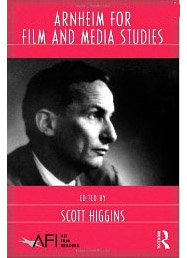 A new anthology seems likely to change that view. Arnheim for Film and Media Studies, edited by Scott Higgins, reveals one of the earliest and most energetic and pluralistic thinkers about modern media. The fourteen authors probe Arnheim’s ideas about film, of course–showing unexpected connections to the Frankfurt School and to avant-gardists like Maya Deren. But there are as well essays on Arnheim’s thinking on photography, television, and radio, along with studies that examine how his ideas would apply to comic books and digital media. Other contributors provide conceptual reconstructions, analyzing his ideas on composition and stylistic history.
A new anthology seems likely to change that view. Arnheim for Film and Media Studies, edited by Scott Higgins, reveals one of the earliest and most energetic and pluralistic thinkers about modern media. The fourteen authors probe Arnheim’s ideas about film, of course–showing unexpected connections to the Frankfurt School and to avant-gardists like Maya Deren. But there are as well essays on Arnheim’s thinking on photography, television, and radio, along with studies that examine how his ideas would apply to comic books and digital media. Other contributors provide conceptual reconstructions, analyzing his ideas on composition and stylistic history.
This is no esoteric exercise. The essays present probing arguments with patient lucidity. Encouragingly, most of the contributors are early in their careers. (I have a piece in the collection as well, an expanded version of a blog entry.) The anthology proves that a seminal thinker can always be reappraised. There’s always more to be understood.
In the Higgins collection Malcolm Turvey furnishes an essay on Arnheim’s relation to various strands of modernism. That vast movement is treated at greater length in Turvey’s new book, The Filming of Modern Life: European Avant-Garde Film of the 1920s. At the book’s core are close analyses of five exemplary films encapsulating various trends. Turvey studies Richter’s Rhythm 21 and abstract film, Léger and Murphy’s Ballet mécanique and cinéma pur, Clair’s Paris Qui Dort and Dada, Dalí and Buñuel’s Chien Andalou and Surrealism, and Vertov’s Man with a Movie Camera and the “city symphony” format. For each film Turvey provides informative historical background and, often, some controversial arguments. For example, he finds Léger to be surprisingly concerned with preserving classical standards of beauty. Indeed, one overall thrust of the book is to suggest that modernism was less a rejection of all that went before than a selective assimilation of valuable bits of tradition. (This applies as well to Eisenstein, I think, as I try to show in my book on his work.)
No less controversial is Turvey’s careful dissection of what has come to be known as “the modernity thesis.” This is the idea that urbanization, technological change, and other forces have fundamentally changed the way we perceive the world, perhaps even altered our basic sensory processes. Specifically, some argue, because the modern environment triggers a fragmentary, distracted experience, that experience is mimicked by certain types of film, or indeed by all films. Step by step Turvey argues that this is an implausible conclusion. This last chapter is sure to stir debate among the many scholars who argue for film’s essential tie to a modern mode of perception.
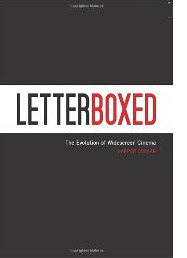 Harper Cosssar’s Letterboxed: The Evolution of Widescreen Cinema begins in the heyday of Arnheim and the silent avant-garde. Indeed, some of the early uses of widescreen, as in Gance’s Napoleon, are indebted to experimental film. But Cossar’s genealogy of widescreen also mentions horizontal masking in Griffith films like Broken Blossoms and lateral or stacked sets in Keaton comedies like The High Sign. More fundamentally, Cossar develops Charles Barr’s suggestion that the sort of viewing skills demanded by widescreen (at least in its most ambitious forms) were anticipated by directors who coaxed viewers to scan the 4:3 frame for a variety of information. The “widescreen aesthetic” was implicit in the old format, and technology eventually caught up to allow it full expression.
Harper Cosssar’s Letterboxed: The Evolution of Widescreen Cinema begins in the heyday of Arnheim and the silent avant-garde. Indeed, some of the early uses of widescreen, as in Gance’s Napoleon, are indebted to experimental film. But Cossar’s genealogy of widescreen also mentions horizontal masking in Griffith films like Broken Blossoms and lateral or stacked sets in Keaton comedies like The High Sign. More fundamentally, Cossar develops Charles Barr’s suggestion that the sort of viewing skills demanded by widescreen (at least in its most ambitious forms) were anticipated by directors who coaxed viewers to scan the 4:3 frame for a variety of information. The “widescreen aesthetic” was implicit in the old format, and technology eventually caught up to allow it full expression.
Cossar advances to more familiar ground, studying early widescreen practice in The Big Trail and moving to analyses of films by masters like Preminger, Ray, Sirk, and Tashlin. Although most chroniclers of the tradition stop in the early 1960s, Cossar presses on to consider the changes wrought by split-screen films like The Boston Strangler and The Thomas Crown Affair. The survey concludes with discussions of cropping techniques in digital animation (e.g., Pixar) and web videos, which often employ letterboxing as a compositional device. In all, Letterbox traces recurring technological problems and aesthetic solutions across a wide swath of film history.
Critics’ corner
Two of America’s senior film writers have revisited their earlier writings, with lively results. Dave Kehr’s collection When Movies Mattered samples his Chicago Reader period, from 1974 to 1986. Disguised as weekly reviews, Kehr’s pieces were nuanced essays on films both contemporary and classic.
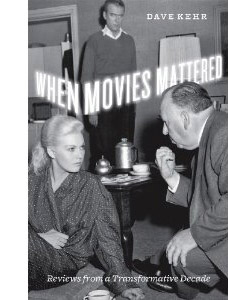 Turn to any of them and you will find a relaxed intelligence and a deep familiarity with film history. By chance I open to his essay on Billy Wilder’s Fedora:
Turn to any of them and you will find a relaxed intelligence and a deep familiarity with film history. By chance I open to his essay on Billy Wilder’s Fedora:
It resurrects the flashback structure of his 1950 Sunset Boulevard, but it goes further, placing flashbacks with flashbacks and complicating the time scheme in a manner reminiscent of such demented 40s films noirs as Michael Curtiz’s Passage to Marseille and John Brahm’s The Locket. . . But the jumble of tenses also clarifies the film’s design as a subjective stream of consciousness. The images come floating up, appearing in the order of memory.
How many of those reviewers whose flash-fried opinions count for so much on Rotten Tomatoes can summon up information about the construction of Passage to Marseille or The Locket? And how many could make the case that Wilder, in returning to the forms fashionable in his early career, would repurpose them for the sake of a reflection on death, resulting in “a film as deeply flawed as it is deeply felt”? Kehr’s work from this period is appreciative criticism at its best, and he never lets his knowledge block his immediate response. “I admire Fedora, but it also frightens me.” It’s time we admitted that Dave Kehr, working far from both LA and Manhattan, was writing some of the most intellectually substantial film criticism we have ever had.
Also hailing from the Midwest is Joseph McBride, a professor, critic, and biographer. Apart from his rumination on Welles, his books have focused on popular, even populist, directors like Capra (The Catastrophe of Success), Ford (Searching for John Ford), and Spielberg (Steven Spielberg: A Biography). The University Press of Mississippi and bringing first two volumes of this trilogy back into print, and it has just reissued the third in an updated edition.
Here Spielberg emerges as far more than a purveyor of popcorn movies. McBride sees him as a restless, wide-ranging artist, and the additions to the original book have enhanced his case. McBride offers persuasive accounts of Amistad and A.I., which he regards as major achievements. He goes on to argue that Spielberg’s unique power in the industry allowed him to face up to central political issues of the 2000s.
He made a series of films in various genres reflecting and examining the traumatic effects of the September 11, 2001, attacks and the repression of civil liberties in the United States during the George W. Bush/ Dick Cheney regime. . . . No other major American artist confronted the key events of the first decade of the century with such sustained and ambitious treatment (450).
McBride is no cheerleader. He can be as severe on Spielberg’s conduct as on his films, criticizing much of the DreamWorks product as dross and suggesting that Spielberg sometimes trims his sails in interviews. I’d contend that McBride underrates some of Spielberg’s work, notably Catch Me If You Can and The War of the Worlds. But McBride has perfected his own brand of critical biography, blending personal information (he reads the films as autobiographical), tendencies within the film industry and the broader culture, and critical assessment. All studies of Spielberg’s work must start with McBride’s monumental book. Ten years from now we can look forward to another update; surely his subject will have made a few more movies by then.
Foreign accents
8 1/2.
Today we regard Citizen Kane as a classic, if not the classic. But for several years after its 1941 release it wasn’t considered that great. It missed a place on the Sight and Sound ten-best critics’ polls for 1952; not until 1962 did it earn a spot (though at the top). Its rise in esteem was due to changes in film culture and, some have speculated, the fact that Kane was a regular on TV during the 1960s. Something similar happened with His Girl Friday, another stealth classic. I’ve traced what I know about its entry into the canon in an earlier blog entry.
What about the postwar classics like Open City and Bicycle Thieves and the works of Bergman and Fellini and Antonioni and Kurosawa and the New Wave? Surely some of the films’ fame comes from their intrinsic quality—many are remarkable movies—but would we regard them the same way if their reputation hadn’t spread so widely abroad, especially in America? Questions like this lead us to what film scholars have come to call canon formation: the ways artworks come to wide notice, receive critical acclaim, and eventually become taken for granted as classics.
 Consider this. The Toronto International Film Festival’s recent list of 100 essential films includes thirty non-Hollywood titles from the 1946-1973 period, more than from any comparable span. Of the TIFF top twenty-five, twelve are from that era. You can argue that these years, during which several generations of viewers overlapped, set in place a system of taste that persists to this day.
Consider this. The Toronto International Film Festival’s recent list of 100 essential films includes thirty non-Hollywood titles from the 1946-1973 period, more than from any comparable span. Of the TIFF top twenty-five, twelve are from that era. You can argue that these years, during which several generations of viewers overlapped, set in place a system of taste that persists to this day.
Tino Balio’s Foreign Film Renaissance on American Screens, 1946-1973 reveals a side of canon formation that’s too often overlooked. Balio is less concerned with analyzing films than Turvey, Cossar, Kehr, and McBride are. He is asking a business question: What led the U. S. film industry to accept and eventually embrace films so fundamentally different from the Hollywood product?
Several researchers have pointed to the roles played by influential critics, film festivals, and new periodicals like Film Comment and Film Culture. Intellectual and middlebrow magazines promoted the cosmopolitan appeal of the foreign imports. By 1963 Time could run a feverish cover story on “The Religion of Film” to coincide with the first New York Film Festival.
Balio duly notes the importance of such gatekeepers and agenda setters. But he goes back to the beginnings, with the small import market of the 1930s. Turning to the prime postwar phase, he broadens the cast of players to include the business people who risked buying, distributing, and publicizing movies that might seem hopelessly out of step with US audiences. He shows how small importers brought in Italian films at the end of the 1940s, and these attracted New York tastemakers, notably Times critic Bosley Crowther, who were keen on social realism. Within a few years ambitious entrepreneurs were marketing British comedies, Swedish psychodramas, Brigitte Bardot vehicles, and eventually the New Waves and Young Cinemas of the 1960s. As distributors fought censors and slipped films into East Side Manhattan venues, an audience came forward. The “foreign films”—often recut, sometimes dubbed, usually promoted for shock, sentiment, and sex—were positioned for the emerging tastes of young people in cities and college towns.
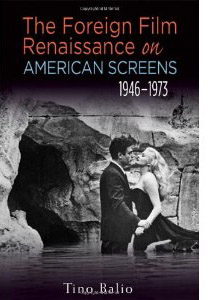 Balio offers fascinating case studies of how the films were handled well or badly. Kurosawa, he notes, had no consistent distributor in the US, and so his films gained comparatively little traction. By contrast there was what one chapter calls “Ingmar Bergman: The Brand.”
Balio offers fascinating case studies of how the films were handled well or badly. Kurosawa, he notes, had no consistent distributor in the US, and so his films gained comparatively little traction. By contrast there was what one chapter calls “Ingmar Bergman: The Brand.”
Bryant Haliday and Cy Harvey of Janus Films. . . devised a successful campaign to craft an image of Bergman as auteur and to carefully control the timing of each release. . . . Janus released the films in an orderly fashion to prevent a glut on the market and to milk every last dollar out of the box office. No other auteur received such treatment.
The work paid off: Bergman made the cover of Time in 1960, and soon The Virgin Spring and Through a Glass Darkly won back-to-back Oscars for Best Foreign Language Film. Eventually, Bergman and other foreign auteurs attracted the big studios. Now that small distributors had shown that there was money in coterie movies, the major companies (having problems of their own) embraced imported cinema—first through distribution and eventually through financing. If you admire Godard’s The Married Woman, Band of Outsiders, and Masculine Feminine you owe a debt to Columbia Pictures, which underwrote them.
Work like Balio’s does more than bring the name Cy Harvey into film history. It reminds us to follow the money. If we do, we’ll see that not every “foreign film” stands radically apart from big bad Hollywood. More generally, The Foreign Film Renaissance on American Screens reminds us that even high-art cinema is produced, packaged, and circulated in an economic system. The distinction between commercial films and personal films, business versus art, is a wobbly one. Rembrandt painted on commission and Mozart was hired to write The Magic Flute. Sometimes good art is good business.
I couldn’t work this in anywhere else: The bulk of the essays in Arnheim for Film and Media Studies are by people associated with our department at Wisconsin. They do us proud, naturally. Incidentally, Joe McBride went to school at UW too, and Tino and I taught together here for over thirty years.
Dave Kehr maintains a blog and teeming forum here.
Hart Perez has made a documentary, Behind the Curtain: Joseph McBride on Writing Film History. An excerpt is here. McBride’s website has information about his many projects.
James E. Cutting provides an unusually precise account of canon creation in his 2006 book Impressionism and Its Canon, available for free download here. I’ve written an earlier blog entry discussing Jim’s research into film.
My mention of American generations is based on Elwood Carlson’s study The Lucky Few: Between the Greatest Generation and the Baby Boom. Carlson examines the varying experiences and life chances of people who fought in World War II; people who came of age during the 1960s; and the less populated cohort that fell in between. Doing some pop sociology, I’d hypothesize that the art-film market’s growth relied on a convergence of all three, which were more disposed to art film than cohorts in earlier periods. For example, veterans who had served overseas and gone to college on the GI Bill were more familiar with non-US cultures than their parents and, I surmise, weren’t entirely put off by foreign films. When I first met Kristin’s mother, Jean Thompson, she already knew the work of Carl Dreyer, having seen Day of Wrath at an art cinema in Iowa City. She was in graduate school after World War II, on the G.I. Bill, as was her new husband, Roger, also in school on the G.I. Bill and managing that art cinema. They saw Children of Paradise and other wartime foreign films just getting their releases in the U.S., as well as post-war films like Bicycle Thieves.
The Lucky Few, also known as the Good Times generation, were born between the late twenties and the early 1940s. They were well placed to enjoy postwar prosperity and the period’s explosion of artistic expression. The Lucky Few cohort includes powerful film critics like John Simon (born 1925), Andrew Sarris (1928), Richard Roud (1929), Eugene Archer (1931), Susan Sontag and Richard Schickel (1933), and Molly Haskell (1939). Aged between twenty and thirty when the foreign-film wave struck, they were mighty susceptible to it. (Pauline Kael, though born in 1919, had a delayed career start, entering film journalism in the 1950s along with Sarris et al.) You might slip in David Thomson (born 1941), Jonathan Rosenbaum (1943), and Richard Corliss (1944).
The Baby Boomers jumped on the carousel in the 1960s, with results that are all too apparent. Dave Kehr and Joe McBride are Boomers, as are Kristin and I. Tino, for the record, is ageless.
Minority Report.
The buddy system
Sweet Smell of Success.
DB here:
Many of our friends write books, and what are friends for if not occasionally to promote each other’s books? Here’s an armload of titles, most of them recently published. They’re so good that even if the authors weren’t our friends and colleagues, I’d still recommend them.
James Naremore has made major contributions to film studies since his fine monograph on Psycho, published way back in 1973. That book remains one of the most sensitive analyses of this much-discussed movie. Now he has another monograph, on the stealth classic Sweet Smell of Success. When I was coming up, Alexander Mackendrick wasn’t much appreciated, and this movie slipped under the radar. More recently it has emerged as one of the model films of the 1950s, and not just for James Wong Howe’s spectacular location cinematography. It’s a very brutal story, with Tony Curtis playing against type as venal press agent Sidney Falco and Burt Lancaster as J. J. Hunsecker, a monstrously vindictive newspaper columnist.
Jim’s book provides a scene-by-scene commentary but also more general analysis of production circumstances and directorial technique. An enlightening instance is what Mackendrick called “the ricochet”—when character A talks to character B but is aiming at character C. This allows the filmmaker great flexibility in framing and cutting, often showing C’s reactions while we hear the dialogue offscreen. In the shots surmounting this blog, Sidney is needling J. J. by asking the Senator if he approves of capital punishment. Jim’s book joins his work on Welles, Kubrick, and film noir as part of a subtle reassessment of American postwar cinema.
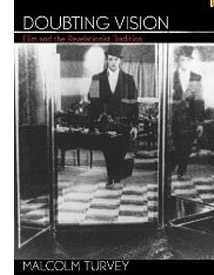 With the current revival of interest in André Bazin’s film theory, it’s fruitful to look again at the “classical” theoretical tradition in which he participated. “Classical” here refers to the very long period before the emergence of semiotic and psychoanalytic theories of cinema in the 1960s. The newer theories have somewhat beclouded our recognition of how imaginative and wide-ranging the old folks were. In Doubting Vision: Film and the Revelationist Tradition, Malcolm Turvey scrutinizes four thinkers who saw film as having the power to show us things beyond (or above, or below) surface reality. In the spirit of analytic philosophy, Turvey carefully lays out the positions of Béla Balázs, Jean Epstein, Siegfried Kracauer, and Dziga Vertov before asking whether their claims hold up.
With the current revival of interest in André Bazin’s film theory, it’s fruitful to look again at the “classical” theoretical tradition in which he participated. “Classical” here refers to the very long period before the emergence of semiotic and psychoanalytic theories of cinema in the 1960s. The newer theories have somewhat beclouded our recognition of how imaginative and wide-ranging the old folks were. In Doubting Vision: Film and the Revelationist Tradition, Malcolm Turvey scrutinizes four thinkers who saw film as having the power to show us things beyond (or above, or below) surface reality. In the spirit of analytic philosophy, Turvey carefully lays out the positions of Béla Balázs, Jean Epstein, Siegfried Kracauer, and Dziga Vertov before asking whether their claims hold up.
I’m not giving much away by revealing that Malcolm thinks the revelationist tendency has its problems. But his purpose isn’t simply to reject the position. He treats it as an instance of what he calls “visual skepticism,” the idea that we ought to treat our ordinary intake of the world as something suspect. This idea, Malcolm argues, is central to modernism in the visual arts. He extends his critique of visual skepticism to more recent theorists as well, notably Gilles Deleuze, and he shows how his own ideas apply to films by Hitchcock, Brakhage, and other directors. Malcolm’s book is a model of theoretical clarity and probity, and a stimulating read as well.
Skepticism of another sort is central to Carl Plantinga’s Rhetoric and Representation in Nonfiction Film. One result of semiotic theory was to question whether a film could ever adequately represent reality. If a movie is only an assembly, however complex, of conventional signs, it can’t give us access to something out there. Even a documentary, some theorists argued, had no privileged access to the real world, let alone to general truths. “Every film is a fiction film” was a refrain often heard at the time. Carl tackles this assumption head-on by carefully arguing that just because a documentary is selective, or biased, or rhetorical, that doesn’t mean that it can’t affirm true propositions about our social lives.
Like Malcolm, Carl brings a philosopher’s training in conceptual analysis to debates about the ultimate objectivity of any documentary. In adopting a position of “critical realism” opposed to skepticism, Carl examines the realistic status of images and sounds, the way documentaries are structured, and filmmakers’ use of technique. He shows, convincingly to my mind, that a documentary may offer an opinion and still be objective and reliable to a significant degree. Carl’s 1997 book went out of print before it could be published in paperback. He has enterprisingly reissued it as a print-on-demand volume, and it’s available here.
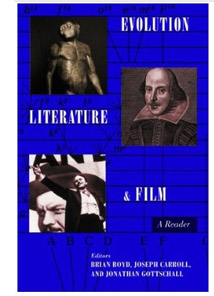 To take film theory in another direction, there’s Evolution, Literature, and Film, edited by Brian Boyd, Joseph Carroll, and Jonathan Gottschall. As a wider audience has become aware of the power of neo-Darwinian thinking, more and more scholars have been arguing that evolutionary theory can shed light on aesthetics. The most visible effort recently is Denis Dutton’s The Art Instinct.
To take film theory in another direction, there’s Evolution, Literature, and Film, edited by Brian Boyd, Joseph Carroll, and Jonathan Gottschall. As a wider audience has become aware of the power of neo-Darwinian thinking, more and more scholars have been arguing that evolutionary theory can shed light on aesthetics. The most visible effort recently is Denis Dutton’s The Art Instinct.
For some years Brian, Joe, and Jonathan have been in the forefront of this trend, with many books and articles to their credit. Their anthology pulls together broad essays on biology, evolutionary psychology, and cultural evolution before turning to art as a whole and then focusing on literature and cinema. There are also pieces displaying evolutionary interpretations of particular works, and a finale that provides examples of quantitative studies of genre, gender variation, and sexuality, including an article called “Slash Fiction and Human Mating Psychology.”
Among the film contributors are other friends like Joe Anderson, a pioneer in this domain with his 1996 book The Reality of Illusion, and Murray Smith, who provides an acute piece called “Darwin and the Directors: Film, Emotion, and the Face in the Age of Evolution.” There are also essays of mine, drawn from Poetics of Cinema. In all, this book presents a persuasive case for an empirical, broadly naturalistic approach to the arts.
By the way, the same team is involved with an annual, The Evolutionary Review, edited by Alice Andrews and Joe Carroll. Its first issue offers articles on Facebook, musical chills, women as erotic objects in film, and Art Spigelman’s In the Shadow of No Towers (by Brian Boyd).
Some books emerge from conferences, and Tom Paulus and Rob King’s Slapstick Comedy is a good instance. Based on “(Another) Slapstick Symposium,” held at the Royal Film Archive of Belgium in 2006, the anthology brings together a host of experts who look back at madcap comedy in American silent film. There are essays on particular creators—Griffith, Sennett, Fatty, and Chaplin, inevitably—as well as pieces on slapstick parodies of other movies and the genre’s relation to modernity, also inevitably. Tom Gunning offers a fine analysis of Lloyd’s Get Out and Get Under (1920), concentrating on a complex string of gags around an automobile. The collection gathers work by some of the outstanding scholars of silent film while also, of course, making you want to see these crazy movies again.
 You also want to see all the movies lovingly evoked by Gary Giddins in Warning Shadows: Home Alone with Classic Cinema. As indicated in another blog entry, I find Giddins one of the best appreciative critics we’ve ever had. Any essay, indeed almost any sentence, cries out to be quoted. Here he is on Edward G. Robinson:
You also want to see all the movies lovingly evoked by Gary Giddins in Warning Shadows: Home Alone with Classic Cinema. As indicated in another blog entry, I find Giddins one of the best appreciative critics we’ve ever had. Any essay, indeed almost any sentence, cries out to be quoted. Here he is on Edward G. Robinson:
His round, thick-lipped, putty face could brighten like paternal sunshine or shut down in implacable contempt or stall with crafty desperation or pontificate with ingenuous wisdom; his short, stumpy, erect frame could sport a tailor-made as smartly as Cary Grant.
Some of the pieces in Giddins’ latest collection were designed to accompany DVDs, but they will outlast this evaporation-prone genre. Other reviews come from the New York Sun, which gave him freedom to mix and match his subjects: Young Mr. Lincoln and Lust for Life (both biopics), Lady and the Tramp and Miyazaki movies. The collection opens with Giddins’ thoughts on how changes in film exhibition, from nickelodeons to digital screens, have altered our relationship with the movies. This isn’t just nostalgia, because his survey allows him to celebrate the power of DVD to exhume forgotten titles. The standards for a film classic, he notes, “are gentler and more flexible” than those in appraising other arts. “The passing decades are a boon to the appreciation of stylistic nuance that gives certain melodramas and genre pieces the heft of individuality.”
Who was Segundo de Chomón? In the 1970s, I kept finding that films I thought were by Méliès turned out to bear this mysterious signature. You imagine a man in a cape and a floppy hat. Photographs show someone a little less operatic, but with a superb mustache. Today he’s far from a mystery, although many of his movies can’t be fully identified. Several scholars have followed his trail, none more thoroughly than Joan M. Minguet Batllori in Segundo de Chomón: The Cinema of Fascination.
Chomón started as a cinema man-of-all-work in Barcelona, translating film titles, distributing copies, and producing films for Pathé. After moving to Paris in 1905, he continued working for the company and established his fame with trick films. He returned to Barcelona to create a production company, but that failed. On he went to Italy, where he specialized in visual effects, most famously for Cabiria (1914).
In his Parisian Pathé years, he was in charge of all the studio’s trick films, which included not only stop-motion, superimpositions, and other effects but also marionettes and animation. Joan argues that he was a prime exponent of the “cinema of attractions,” Tom Gunning’s term for that early mode of filmmaking which aims to startle and enchant the audience. A famous instance is Kiriki, acrobats japonais (1907), which shows gravity-defying stunts.
Chomón accomplished this by shooting from straight down, filming the performers on the floor. They had to simulate leaps and flips as they rolled along each other’s bodies, and then they had to slip perfectly into position. This English edition of Joan’s book on Chomón, full of information and providing a “provisional filmography” along with many pages of gorgeous color images, will be available soon here.
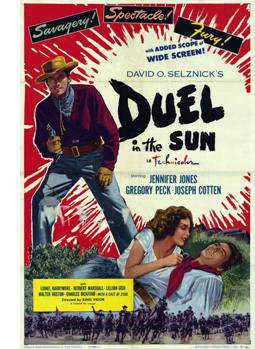 We recently noted the anniversary of our book on classic studio cinema, a 1985 project in which we bypassed talking about exhibition. That part of the industry has been a scholarly growth area in the years since, and one of the newest yields is Epics, Spectacles, and Blockbusters: A Hollywood History, by Sheldon Hall and Steve Neale. It’s a chronological account of Big Movies, from the earliest features to the digital era, and it concentrates on how such films have been marketed and shown. It explains how exhibition changed across the decades, and how we got the phenomenon of the “roadshow” movie, the film shown selectively (only certain cities), at intervals (perhaps only one matinee and one evening screening), and at more or less fixed prices. My middle-aged readers will remember roadshow releases like The Sound of Music (1965), although there were many before and even a few since.
We recently noted the anniversary of our book on classic studio cinema, a 1985 project in which we bypassed talking about exhibition. That part of the industry has been a scholarly growth area in the years since, and one of the newest yields is Epics, Spectacles, and Blockbusters: A Hollywood History, by Sheldon Hall and Steve Neale. It’s a chronological account of Big Movies, from the earliest features to the digital era, and it concentrates on how such films have been marketed and shown. It explains how exhibition changed across the decades, and how we got the phenomenon of the “roadshow” movie, the film shown selectively (only certain cities), at intervals (perhaps only one matinee and one evening screening), and at more or less fixed prices. My middle-aged readers will remember roadshow releases like The Sound of Music (1965), although there were many before and even a few since.
Sheldon and Steve trace in unprecedented detail the cycles of blockbusters that have run throughout American cinema. In the process they refreshingly redefine the very idea. We don’t usually think of The Best Years of Our Lives as a Big Movie, but it runs three hours and was considered a “special” production, comparable to the more obvious sprawl of Duel in the Sun. The authors bring the story up to date by considering today’s event movies as a “Cinema of Spectacular Situations.” Yes, that category includes comic-book films, Inception, and, of course, the 3D sagas that may finally be wearing out their welcome. (My editorializing, not theirs.)
Japanese cinema is endlessly fascinating in all its eras; I’d argue that in toto it’s one of the three greatest national cinemas in film history. The postwar period is exceptionally interesting because of the American occupation (1945-1951) and its effects on Japanese film culture. This period has already provoked one of the best books we have on Japanese cinema, Kyoko Hirano’s Mr. Smith Goes to Tokyo, and it finds a worthy accompaniment in Hiroshi Kitamura’s Screening Enlightenment: Hollywood and the Cultural Reconstruction of Defeated Japan. Kyoko focused on how US policy shaped domestic filmmaking, while Hiroshi asks how the Occupation helped American studios penetrate the local market.
Over six hundred Hollywood movies poured into Japan during the period, and Hiroshi traces how local tastemakers as well as U.S. policymakers drew audiences to them. Young Japanese learned about the Academy Awards, assembled in movie-study clubs to discuss what they were seeing, and were urged to consider even a gangster tale like Cry of the City (1950) as demonstrating the humanistic side of democracy. A center of this activity was Eiga no tomo (“Friends of the Movies”), a magazine that went beyond entertainment news and tried to reshape the tastes of young people. In sharp prose and vivid evidence, Hiroshi captures the ways in which American cinema promised to help heal a devastated country.
 The Danish Directors, by Mette Hjort and Ib Bondebjerg, has become a standard companion to the most successful “small cinema” on the European scene. Now it has a successor in The Danish Directors 2: Dialogues on the New Danish Fictional Cinema, edited by Mette, Eva Jorholt, and Eva Novrup Redvall. Once again, we get lengthy, in-depth interviews covering the value of film education, the vagaries of funding, and filmmakers’ creative decision-making. Lone Scherfig, Christoffer Boe, Per Fly, Paprika Steen, and many other major figures are included. (Disclosure: The editors were kind enough to dedicate the book to me.)
The Danish Directors, by Mette Hjort and Ib Bondebjerg, has become a standard companion to the most successful “small cinema” on the European scene. Now it has a successor in The Danish Directors 2: Dialogues on the New Danish Fictional Cinema, edited by Mette, Eva Jorholt, and Eva Novrup Redvall. Once again, we get lengthy, in-depth interviews covering the value of film education, the vagaries of funding, and filmmakers’ creative decision-making. Lone Scherfig, Christoffer Boe, Per Fly, Paprika Steen, and many other major figures are included. (Disclosure: The editors were kind enough to dedicate the book to me.)
While the first volume is a rich storehouse of information on Danish film in “the Dogma era,” the newest volume shows how directors (some of whom made Dogma projects) have gone beyond it. In preparing 1:1, a film about Danes and Arab immigrants living in a housing project, Annette K. Olesen had a full script but concealed it from the non-professional cast. After getting the performers comfortable with ordinary situations, she began staging scenes while encouraging improvisation. Screenwriter Kim Fupz Aakeson incorporated the improvised material into revisions of the script.
By contrast, the prolific director-screenwriter Anders Thomas Jensen (Adam’s Apples, The Green Butchers), relies on strong structure, with lean expositions and sharply defined climaxes. He appreciates clean filming technique too.
It’s easy to make something that’s ugly and handheld, but you have to take telling stories with images seriously. You have to take the language of film seriously. Many Danish directors have started doing this in recent years and it’s wonderful, because there was a time when everything looked Dogma-like and I found myself thinking, “It’s got to stop now.”
To those who think that Danish cinema is at risk of becoming a cinema of cozy liberal reassurance, this collection offers many salutary signs. Every director speaks of the need to keep innovating, to push ahead provocatively. Simon Staho, whose Day and Night seems to me one of the most adventurous Danish films of recent years, aims at utter purity: “My task is to figure out how to add as little as possible to the black screen. The damned problem is that you have to add image and sound!”
What makes all these books exciting to me is a willingness to test ideas–sometimes very general ones–about cinema and the wider world by examining film as a distinctive art form. Even the most conceptual books on this week’s shelf are firmly rooted in the particular choices that creators make and the concrete ways that viewers respond.
Next stop: Vancouver International Film Festival. Whoopee!
Day and Night.












